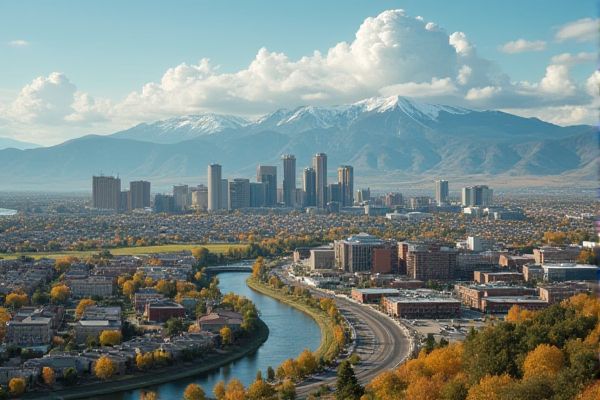
What to know as new resident in Idaho: Weather conditions and seasonal changes. Local traffic and road rules. Outdoor recreational activities. Idaho's tax structure. Cost of living variations. Local school districts and education options. Community events and festivals. Local cuisine and dining spots. Public transportation availability. Neighborhood safety and amenities.
Weather conditions and seasonal changes.
As a new resident in Idaho, you should be aware that the state experiences significant weather and seasonal variability. Idaho's climate ranges from dry rangelands in the south to temperate wet forests in the panhandle, with mid-latitude storms bringing precipitation during the cool season from November to May and generally dry summers, while mountainous areas receive substantial snowfall that affects travel and water availability. For more detailed information about relocating, you can visit the Idaho Government's official website, which provides resources and guidance tailored to newcomers.
Local traffic and road rules.
As a new resident in Idaho, it's important to know about unique traffic laws such as the "permissive yellow light" rule, the "Idaho Stop Law" allowing bicyclists to treat stop signs as yield signs and red lights as stop signs, and specific rules for turning left on red lights, particularly onto one-way streets. Additionally, be familiar with navigating roundabouts and understanding the rules for median U-turns in certain areas. For more in-depth information about these regulations, the Idaho Statesman provides valuable insights on local traffic laws that could greatly benefit new residents acclimating to driving in Idaho.
Outdoor recreational activities.
As a new resident in Idaho, you can explore a wide range of outdoor recreational activities, including biking, hiking, and horseback riding, watersports, fishing, motorsports, and camping, with extensive trails, rivers, lakes, and public lands available for various adventures. For more information on these activities and responsible recreation practices, visit Recreate Idaho to ensure a memorable and sustainable experience in the natural beauty of the state.
Idaho’s tax structure.
Idaho's tax structure now features a flat income tax rate of 5.8% for all taxpayers, applicable to taxable income over $4,489 for single filers and $8,978 for joint filers, effective January 1, 2023. In addition to simplifying the income tax bracket, the state offers property tax relief, which is a significant benefit for homeowners. Moreover, the dependent care tax deduction has been increased to $12,000 per year, providing further financial assistance to families. For more detailed information, you can visit the Idaho State Tax Commission website to stay updated on tax guidelines and benefits.
Cost of living variations.
In Idaho, the cost of living is notably 6% lower than the national average, with essential expenses such as housing and utilities being significantly reduced by 16% and 15%, respectively. This financial relief is slightly offset by transportation costs, which are 11% higher. Within the state, there are noticeable variations between cities; for instance, Boise stands out with its cost of living being 5% higher than the national average, contrasting sharply with Idaho Falls, where it is 16% lower. For a detailed assessment and comparison of living costs across various locations, you can explore the RentCafe Cost of Living Calculator.
Local school districts and education options.
In Idaho, families have access to a variety of education options, such as traditional public schools, public charter schools, public magnet schools, homeschooling, and online learning. This diversity in educational opportunities is further complemented by the state's inter-district and intra-district open enrollment policies, which permit students to attend schools beyond their designated zones. For more detailed information on these education options and policies, you can visit the official EdChoice Idaho page.
Community events and festivals.
As a new resident in Idaho, you can explore a wide range of community events and festivals throughout the year, including seasonal celebrations like the Trailing of the Sheep Festival, Sun Valley Jazz and Music Festival, Idaho Potato Drop, and various summer fests, winter carnivals, and spring cultural events across different regions of the state. To discover a comprehensive list of exciting events, visit the Visit Idaho website, which provides detailed information about the vibrant and diverse happenings that bring together locals and visitors alike.
Local cuisine and dining spots.
As a new resident in Idaho, you should know that the local cuisine goes beyond potatoes, featuring iconic dishes like finger steaks, Idaho ruby red trout, huckleberry treats, and unique desserts like the ice cream potato. With notable dining spots including Lindy's Steak House, Westside Drive-In, and Elevation 486, discovering what the state has to offer is a delightful journey. For a comprehensive guide on these culinary delights, visit the Food Network website and explore what to eat in Idaho.
Public transportation availability.
As a new resident in Idaho, you can access a variety of public transportation services, including statewide and local transit systems such as Greater Idaho Falls Transit (GIFT), Pocatello Regional Transit (PRT), and Southern Teton Area Rapid Transit (START), among others. These services offer fixed-route, on-demand, and intercity bus options to meet various mobility needs. For a comprehensive overview of these options, you can explore the resources available on the Idaho Transportation Department website.
Neighborhood safety and amenities.
Idaho is generally a safe state, but new residents should be aware that crime rates vary by area. Cities like Twin Falls and Pocatello have higher violent crime rates, while Lewiston has the highest property crime rate. However, smaller towns like Sun Valley have exceptionally low crime rates, making them very safe. When choosing a neighborhood, consider areas like Knull in Twin Falls or City Center in Idaho Falls, which are noted as safer neighborhoods within their respective cities. For more detailed insights on safety, visit the Safest Cities in Idaho page for comprehensive information about various regions within the state.
